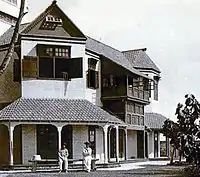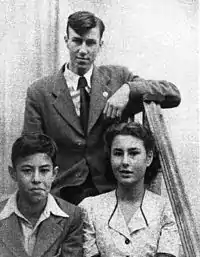Clunies-Ross family
The Clunies-Ross family were the original settlers of the Cocos (Keeling) Islands, a small archipelago in the Indian Ocean. From 1827 to 1978, the family ruled the previously uninhabited islands as a private fiefdom, initially as terra nullius and then later under British (1857–1955) and Australian (1955–1978) sovereignty. The head of the family was usually recognised as the resident magistrate, and was sometimes styled as the "King of the Cocos Islands" – a title given by the press.

History
John Clunies-Ross
John Clunies-Ross was a merchant born in Weisdale, Shetland on 23 August 1786.[1] In 1813 he was at Timor as Third Mate on board the whaler Baroness Longueville when he received the opportunity to become captain of the brig Olivia, which he took.[2] He reportedly first cruised the waters of the then uninhabited Cocos (Keeling) Islands in 1825. After surveying them he moved his family to live on one of the islands in 1827.[3][4][5] Only Joshua Slocum used different dates, when he wrote that "John Clunis-Ross, who in 1814 touched [the island] in the ship Borneo on a voyage to India", nailed up a Union Jack with plans to settle in the future and "[...] returned 2 years later with his wife and family".[6]
In 1823 an English adventurer, Alexander Hare, had settled on another of the islands with some runaway slaves. However, Hare soon departed and Clunies-Ross alone obtained permanent rights by settlement.[7] He planted hundreds of coconut palms and brought in Malay workers to the islands in order to harvest the nuts, building a business by selling copra.[8] In the beginning, Javanese convicts were used as labourers and "crime of all kinds was rife", before "getting rid of the criminal class and obtaining a better type of Malay coolie."[3]
According to a 1903 article in The Timaru Herald, Ross "...[ran] his little colony on model lines and succeeded beyond expectation" and Charles Darwin mentioned after his 1836 visit with HMS Beagle that he "found the natives in a state of freedom".[4] However the article left out the sentence that immediately followed: "but in most other points they are considered as slaves".[5][9] Ross traded with Dutch vessels going to Dutch ports on Java and Sumatra and became a naturalised Dutch subject;[4] he had approached both the British and the Dutch government for annexation but neither had responded.[3]
John George Clunies-Ross
In 1854, his son John George Clunies-Ross (born 1823) took over under the name of Ross II.[10] In 1857 British Captain Stephen Grenville Fremantle visited aboard HMS Juno who "took possession of the islands in the name of the Britannic Majesty's Government." Fremantle appointed John George as superintendent of the islands and left after a 3-month vacation. The connection to Britain changed nothing in Ross's autonomous administration, and it was not until fifteen years later another British ship arrived for a complete survey of the island.[4] Apparently, Fremantle annexed the islands by mistake, thinking he had arrived on the Coco Islands of the Andaman Islands.[3]
John George Clunies-Ross received the native title of Tuan Pandai ('the learned one') due to his amateur medical knowledge and research into the natural history of the islands. The head of the family Clunies-Ross kept the title 'Tuan', a term that can be translated as 'sir'.[10] He married S'pia Dupong, a Malaysian of high-rank, in 1841.[11]
George Clunies-Ross
Born on 20 June 1842 in the Cocos Islands to John George Clunies-Ross and S'pia Dupong, George Clunies-Ross was sent to Scotland where he studied engineering at Glasgow.[7] In 1871, known as Tuan Tinggi,[11] he became superintendent after his father died,[4][11] then married Inin (1850–1889),[10] a Malaysian of high-rank like his mother.[7] It was during his administration, in 1885, that the first annual inspection by a representative of the Straits Settlements Government occurred.[3]
In 1886 Queen Victoria granted the islands in perpetuity to the Clunies-Ross family.[8] Representatives of the Government of the Straits Settlements were sent to the island each year and reports reflected that "members of the Clunies-Ross family are to-day in every sense of the word proprietors of the islands, for Mr George Clunies-Ross makes his own laws and interprets them, polices his little domain, provides his own coinage [...] controls the entire trade and acts as "the universal provider" to satisfy the wants of the community".[4] According to Chambers' Journal, there had not been any metallic coins since 1837.[3] Six years after Inin's death, George Clunies-Ross married Ayesha, a former boi (servant) in 1895.[11]
In 1903, the islands were annexed to the Straits Settlements and incorporated as part of the settlement of Singapore, without affecting the ownership of the territory. George Clunies-Ross died on 7 July 1910 at Ventnor, in the Isle of Wight, after going to England for medical treatment.[7][1] His body was taken back to the Cocos in 1914.[1]
John Sidney Clunies-Ross

John Sidney Clunies-Ross was born in the Coco Islands on 13 November 1868, the son of George Clunies-Ross and Inin. Known as Tuan Ross, he inherited from an economic disaster after a cyclone destroyed almost every houses and coconut palms on Home Island in November 1909.[11]
During the Second World War, the Coco islands served as a major base for the Royal Air Force. John Sidney Clunies-Ross died of a heart attack during a Japanese bombing on the islands in August 1944. The British military took over control of Home Island until John Cecil Clunies-Ross returned to the Cocos on 6 July 1946.[12][10]
John Cecil Clunies-Ross
The title to the islands was claimed by the Ross family until 1978, when John Cecil Clunies-Ross (born 29 November 1928),[12] known as Tuan John,[10] sold them to the Commonwealth of Australia for £2.5m ($4.75m) under threat of expropriation,[8][13] with the exception of his house on Home Island, which was eventually purchased by the government in 1993.[14] The Commonwealth had already been administering the islands since Novembre 1955, with the proclamation of the Cocos (Keeling) Island Act 1955.[14]
John C. Clunies-Ross eventually went bankrupt after the Australian government refused to give any business to his shipping line company. He then moved to Perth with his wife.[8][13] During the 1984 referendum, he campaigned for independence but the majority of the islanders chose integration with Australia.[13]
Legacy
As of 2007, John "Johnny" George Clunies-Ross (born 1957[15]), the son of John C. Clunies-Ross, lives on the West Island, breeding clams. He stated that he was initially frustrated with the 1978 transfer of the islands to Australia, but that he had changed his mind since then: "I was 21 and I'd been brought up to do the job. But even in the old man's time, it had become anachronistic. It had to change".[8]
List of Kings
| King[8][13] | Regnal name[16][12] | Native title[11][10] | Born-Died | From[12][10] | Until[12][10] |
|---|---|---|---|---|---|
| John Clunies-Ross | Clunies-Ross I | 1786–1854 | 1827 | 1854 | |
| John George Clunies-Ross | Clunies-Ross II | Tuan Pandai | 1823–1871 | 1854 | 1871 |
| George Clunies-Ross | Clunies-Ross III | Tuan Tinggi | 1842–1910 | 1871 | 1910 |
| John Sidney Clunies-Ross | Clunies-Ross IV | Tuan Ross | 1868–1944 | 1910 | 1944 |
| John Cecil Clunies-Ross | Clunies-Ross V | Tuan John | 1928–2019 | 1946 | 1978 |
See also
- List of administrative heads of Cocos (Keeling) Islands
- Ian Clunies Ross, prominent Australian scientist and administrator and relative of the Clunies-Ross family
- Alfred Clunies-Ross, the first non-white rugby union international player and relative of the Clunies-Ross family
References
- Gibson-Hill, C. A. (1952). "Documents relating to John Clunies Ross, Alexander Hare and the early history of the settlement on the Cocos-Keeline Islands". Journal of the Malayan Branch of the Royal Asiatic Society. 25 (4/5 (160)): 5–306. ISSN 2304-7550. JSTOR 41502769.
- Farram, Stephen (2007) "Jacobus Arnoldus Haazart and the British interregnum in Netherlands Timor, 1812-1816". Unpublished work accessed 8 November 2016.
- "The Cocos Islands". The Chambers's Journal. Edinburgh. 76: 187–190. 1899. Retrieved 12 April 2016.
- Long, Edward E. (3 October 1903). "King of the Cocos Island". Timaru Herald, Volume LXXIX, Page 2 (12187). Via Government of New Zealand. Retrieved 15 February 2015.
- "Dynasties series: Clunies-Ross Timeline, episode 2". www.abc.net.au. ABC Australia. 16 November 2004. Archived from the original on 31 August 2014. Retrieved 12 April 2016.
- Joshua Slocum, (1901) "Sailing Alone Around the World", New York Century Co, Pan American edition, p. 212
- im Thurn, Everard Ferdinand (1912). "Clunies-Ross, George". Dictionary of National Biography. 1.
- Nick Squires The man who lost a 'coral kingdom' BBC News, 7 June 2007
- Keynes, Richard (2001), Charles Darwin's Beagle Diary, Cambridge University Press, pp. 413–418, retrieved 12 April 2016
- Irving, David R. M. (2019). "Strings across the ocean: practices, traditions, and histories of the Cocos Malay biola in the Cocos (Keeling) Islands, Indian Ocean". Ethnomusicology Forum. 28 (3): 283–320. doi:10.1080/17411912.2020.1754874. hdl:10261/215984. ISSN 1741-1912.
- Hunt, J.G. (1989). "The revenge of the Bantamese: factors for change in the Cocos (Keeling) Islands, 1930-1978". The Australian National University. doi:10.25911/5d7637458205c.
- "Heir to the Coco Islands". Pacific islands monthly. XX (3). October 1949. p. 13.
- Wynne, Emma (6 April 2019). "There was trouble in paradise until Cocos Islanders changed their destiny". ABC News. Retrieved 11 July 2020.
- "The Cocos (Keeling) Islands" (PDF). National Archives of Australia.
- "Trove". trove.nla.gov.au. Retrieved 11 July 2020.
- "Cocos Island: The King Is Dead". Time. 11 June 1945. ISSN 0040-781X.
Further reading
- Clunies-Ross, John Cecil; Souter, Gavin The Clunies-Ross Cocos Chronicle, Self, Perth 2009, ISBN 9780980586718
- Ross, J. C. (May 1835). "The Cocos' Isles. Letter to the Editor, New Selna, Cocos' Isles, July 8th, 1834". Blackwoods Edinburgh Magazine. The Metropolitan, part 1. Peck and Newton. pp. 219–221.
External links
- Cocos Island page Genealogical Gleanings